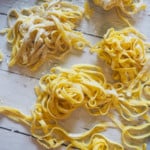

Paleo Egg Noodle Pasta
This Paleo pasta is so light and silky. These noodles are just the right amount of eggy and doughy for a big bowl of fettuccine or a comforting bowl of chicken noodle soup.
Servings: 6
Calories: 168kcal
Equipment
- pasta maker
- a rolling pin
- stand mixer with a dough hook
Ingredients
- 1 cup almond flour
- ½ cup tapioca starch
- 1 tsp xanthan gum
- ¼ tsp kosher salt
- 1 tsp olive oil
- 2 eggs
Instructions
- First, add your dry ingredients to the bowl of a mixer with a dough hook.
- Make a small well in the middle and drop in your eggs.
- Then, let your dough hook do the work. You may need to stop the mixer and scrape down the sides a few times, but it will eventually all start sticking together into a ball. Let the mixer knead the dough for a few minutes - there is no gluten in this, so it won't seize up on you if you over mix it.
- Next, remove your ball of dough and place it onto a surface that is sprinkled with tapioca starch.
- Roll the dough flat with a rolling pin.
- Then cut the dough into strips about ½ to ⅔ the width of your pasta maker. (Once you start feeding the dough through the pasta maker, it will get thinner and wider.)
- Now, feed the dough through the sheet pasta maker on the widest setting, once or twice to smooth it out. On my pasta maker, that is #1.
- When you are laying out the flattened sheets, dust them with a little bit of tapioca starch to keep them from getting stuck to anything.
- After I put all of the sheets through at #1, I switch it to #2 and put them all through again. It doesn't really matter if the dough makes perfect rectangles when being flattened - I love to use these noodles for soup, so I can use the short pieces from this as soup "egg noodles."
- When the sheets have all gone through #2, you can test out feeding some through #3 or switch to your spaghetti or fettuccine cutter. (You don't want to make this pasta too thin.)
- When using the fettuccine cutter, feed the pasta sheet through and allow the beautiful fettuccine to drape over your hands at it comes out. (This pasta doesn't need to be hung to dry like traditional pasta and it won't stick to itself as soon as you cut it. I toss the pasta in a little tapioca starch and pile it into small "nests."
- Cook the pasta in boiling water with a drizzle of olive oil. It will cook quickly - you will know it is cooked about the time when it floats to the top (a reader noted that it takes about 4 minutes for them - thanks!) Alternatively, freeze your pasta "nests" on a cookie sheet then transfer to a ziplock bag or Tupperware for storage.
Notes
If you dough too dry or crumbly, you can add a little bit of water to stick it all together.
You can try to take the dough thinner than #2 or #3, but the dough becomes pretty thin and fragile this way. (With traditional pasta, you can go all the way down to #6 or #7, but this dough will tear if you do that.)
Sprinkle tapioca starch on everything - this dough is not as sticky as traditional pasta, but it will get stickier as you work the dough more and warm it up.
This pasta freezes really well. I make little "nests" and freeze them on a cookie sheet. Then they can be packaged together. To cook, just drop the nests into boiling water or soup from frozen.
If you do not have a pasta maker, you can roll your pasta thin with a rolling pin, then using a ruler and a pizza cutter - slice your dough into nice long ribbons. This is also how I make dumplings for Chicken and Dumplings - roll the dough to about an eighth or quarter of an inch, then cut into small rectangles using a ruler and a knife or pizza cutter.
Nutrition
Calories: 168kcal | Carbohydrates: 13g | Protein: 6g | Fat: 11g | Saturated Fat: 1g | Cholesterol: 55mg | Sodium: 132mg | Potassium: 20mg | Fiber: 2g | Sugar: 1g | Vitamin A: 79IU | Calcium: 47mg | Iron: 1mg